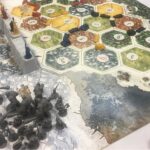In the world of board game development, striking the right balance is an art form. You want your game to be mechanically sound, strategically engaging, and ultimately, a whole lot of fun. But achieving this perfect harmony can feel like a juggling act. Fear not, aspiring game designers! This guide will equip you with the knowledge and tools to create a balanced board game experience that will have players coming back for more.
What is Balance in Board Game Development?
Balance, in the context of board game development, refers to creating a fair and engaging experience for all players. It ensures that every player has a reasonable chance of winning, regardless of their starting position or luck of the draw. It also means your game mechanics and strategies offer a variety of paths to victory, keeping gameplay fresh and exciting.
The Three Pillars of Board Game Balance
A balanced board game rests on three fundamental pillars: mechanics, strategy, and fun. Let’s delve deeper into each:
1. Mechanics:
Mechanics are the core rules and systems that govern how your board game operates. This includes things like player actions, resource management, victory conditions, and even the components themselves (dice, cards, boards). Well-designed mechanics are intuitive, engaging, and create a smooth flow of gameplay.
2. Strategy:
Strategy is what separates a good board game from a great one. It’s the layer of decision-making that allows players to utilize their skills and knowledge to outmaneuver their opponents. Balanced board games offer a variety of strategic options, ensuring no single strategy dominates the game.
3. Fun:
This might seem obvious, but sometimes the pursuit of perfect mechanics and strategy can overshadow the most important element – fun! A balanced board game keeps players engaged, creates moments of excitement and surprise, and leaves them wanting to play again.
How to Achieve Balance in Your Board Game
Now that we understand the pillars of balance, here are some practical tips to incorporate them into your board game development process:
-
Playtesting is Key: The single most important factor in achieving balance is playtesting. Gather a diverse group of players and observe their interactions with your game. Look for imbalances, exploitable strategies, or mechanics that bog down gameplay. Iterate and refine your design based on your observations.
-
Variety is the Spice of Life: Offer players a variety of ways to achieve victory. This can be through different resource acquisition strategies, unique player abilities, or alternative win conditions.
-
Asymmetric Balance: Consider asymmetric gameplay where players have different starting abilities or powers. This can add strategic depth while maintaining balance by carefully designing each player’s strengths and weaknesses.
-
Randomness with Purpose: Randomness can add excitement, but too much can lead to frustration. Use random elements strategically, like dice rolls or card draws, to create opportunities for tactical decisions and unexpected outcomes.
-
Component Design Matters: Carefully consider the size and complexity of game components. Fiddly pieces or overly complex boards can hinder gameplay flow and enjoyment.
Real-World Example: Balancing Luck and Strategy in Ticket to Ride
Ticket to Ride is a popular board game that masterfully balances luck and strategy. While drawing train cards introduces an element of randomness, players can mitigate some of that luck by strategically claiming routes and collecting specific color sets.
Conclusion: The Balancing Act
Developing a balanced board game takes time, effort, and a willingness to adapt your design. By focusing on clear mechanics, offering diverse strategies, and prioritizing fun, you’ll be well on your way to crafting a game that will be enjoyed by players of all skill levels. Remember, a balanced board game is a game that keeps players engaged, keeps them coming back for more, and ultimately, creates a sense of satisfaction for both the players and the game designer. Now go forth, fine-tune your game mechanics, and create an experience that will truly stand out!

